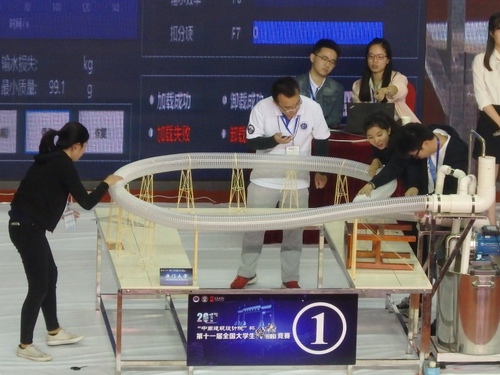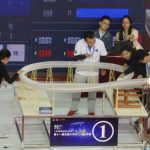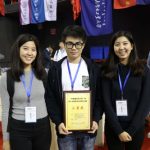 The UM team and their model structure
The UM team and their model structure
Three students from the Department of Civil and Environmental Engineering, Faculty of Science and Technology (FST), University of Macau (UM), recently won a third prize at the 11th National Structure Design Contest for College Students held in Wuhan.
The three students are Wong Chan Hou, Ieong Un Teng, and Ieong Un Kio. They competed with 108 teams formed by more than 300 faculty members and students from 107 universities in China. The participating teams in the final are winners of preliminary contests held in their respective provinces. This year, teams from a total of 1,182 universities participated in the preliminary contests.
The theme of this year's competition is 'Long-span Water Pipe Supporting Structure'. Each team was required to design and fabricate a long-span bamboo water pipe supporting structure which was used to support a 6.5-metre water pipe with a full water load of 50 kilograms. Water needed to be fully loaded to the water pipe, which was followed by a process of unloading water. The model submitted by UM was a combination of a cable net system and a series of column assemble. The model weighed 179.2 grams and the structure passed both the loading and unloading test.
Wong says that the competition allowed him to put knowledge into practice, broadened his horizons, and improved his civil engineering skills. The supervisors of the UM team are FST associate professors Er Guokang and Lam Chi Chiu. Tou Ka Man, a technician from the Structures Laboratory of the Department of Civil and Environmental Engineering, provided assistance with the team’s model testing at UM.
Co-organised by the professional advisory committee for civil engineering programmes at higher education institutions and the educational affairs committee of China Civil Engineering Society, the annual competition is one of the nine highest-ranked inter-varsity competitions in science and engineering in China. It is also the most important competition in the field of civil engineering. The event aims to provide a platform for civil engineering students to exchange ideas, build friendships, improve civil engineering skills, apply their creativity, and learn how to work with others. It also hopes to strengthen ties among civil engineering departments at various universities.
View gallery


